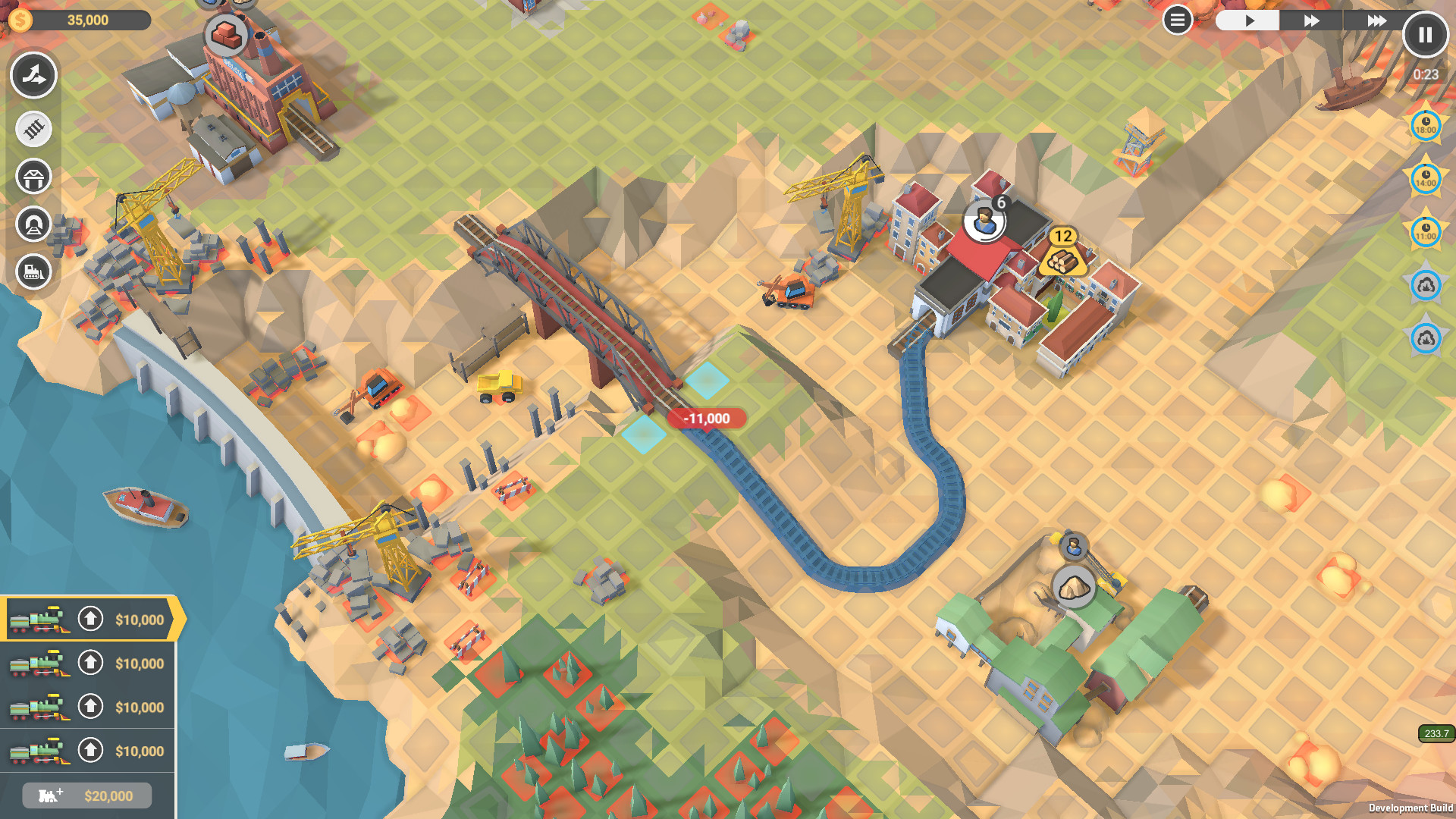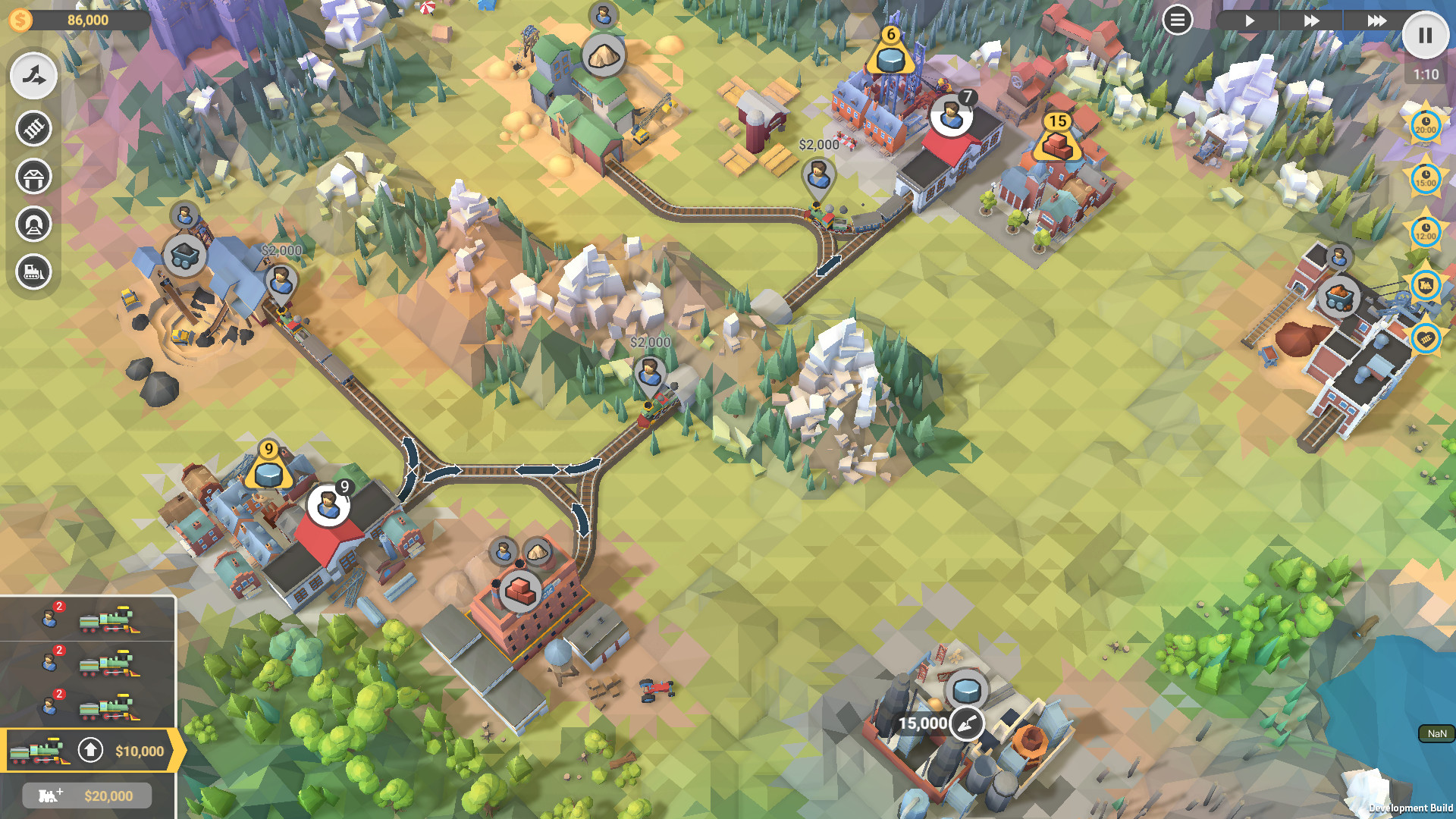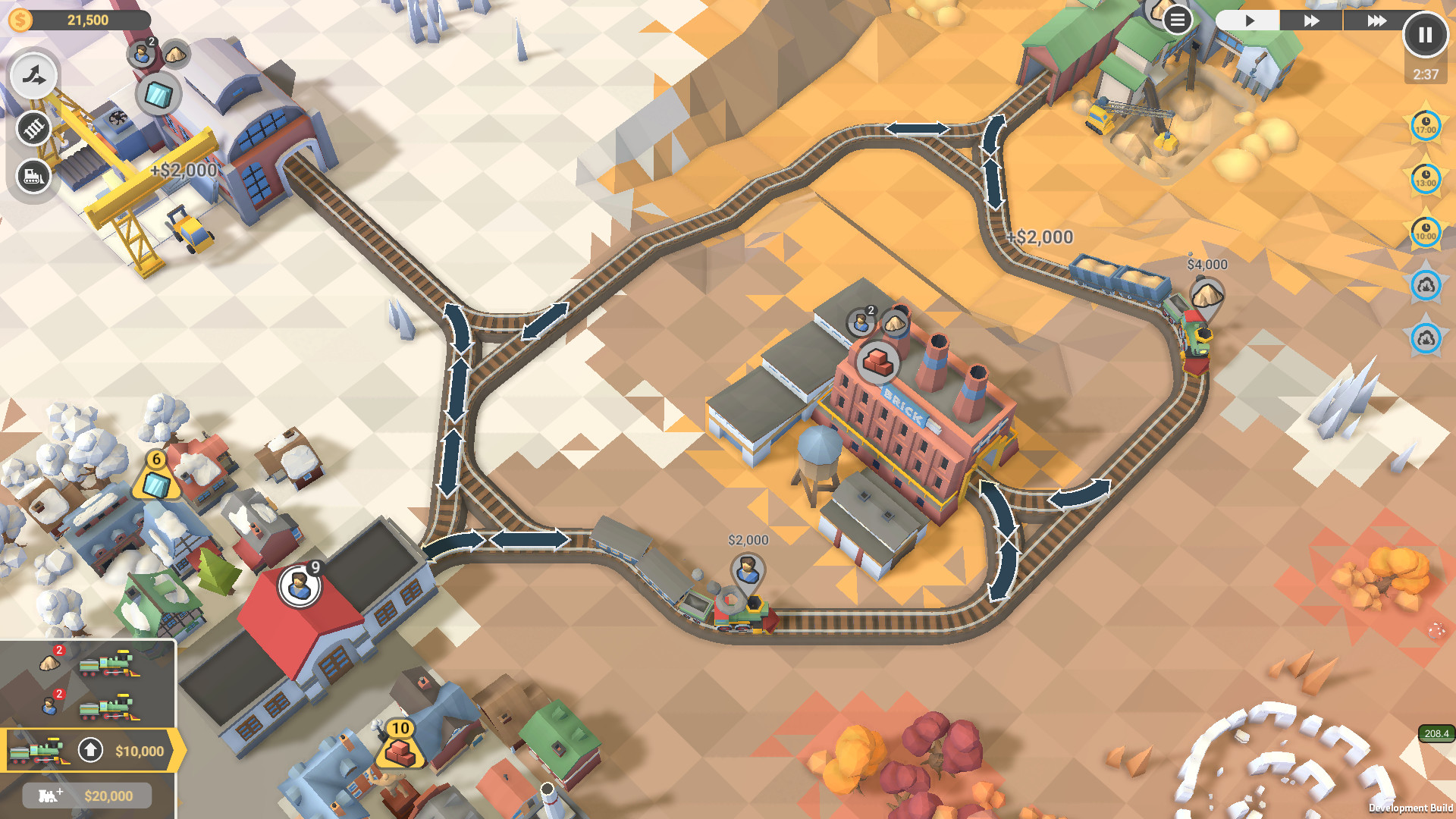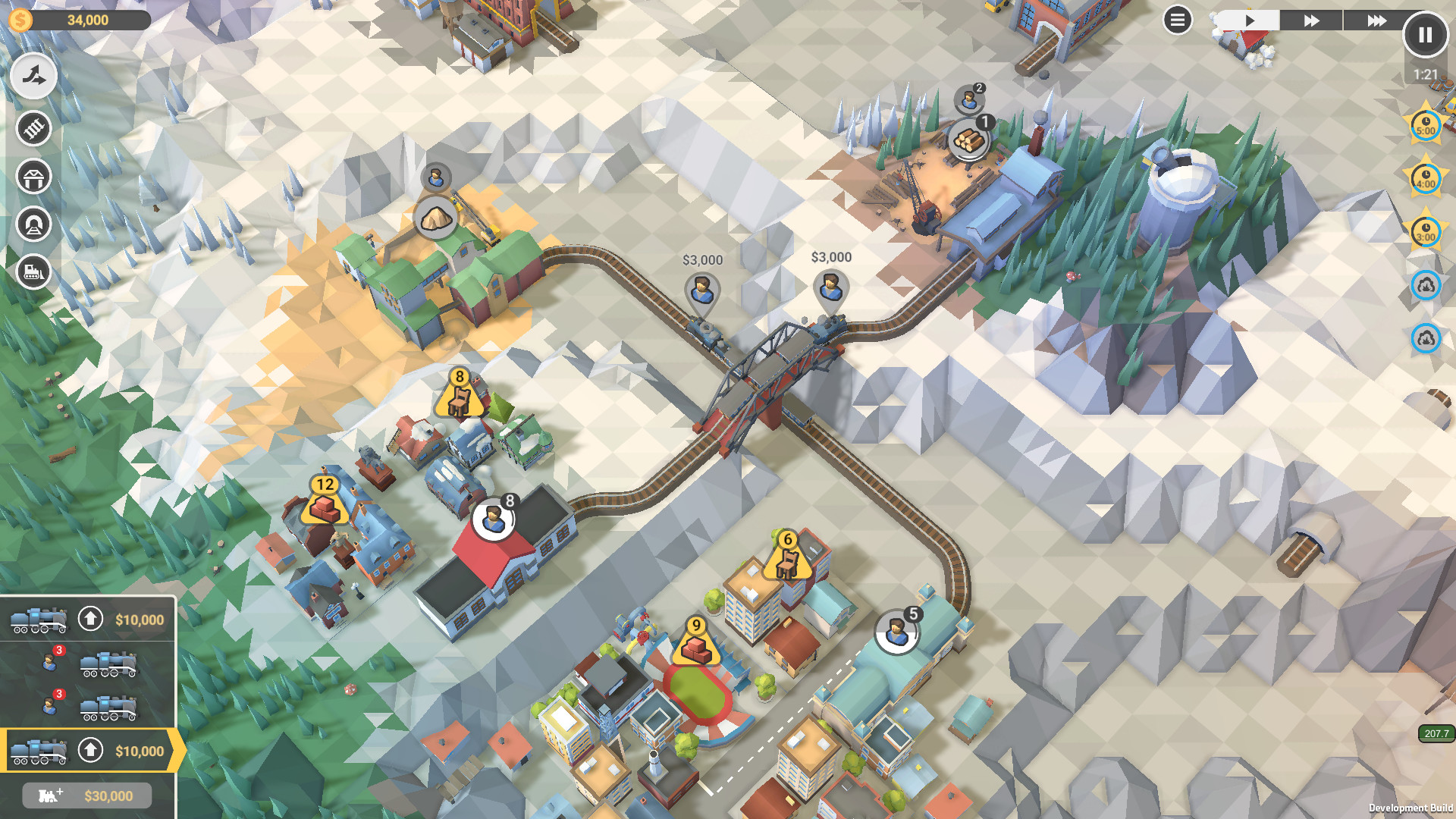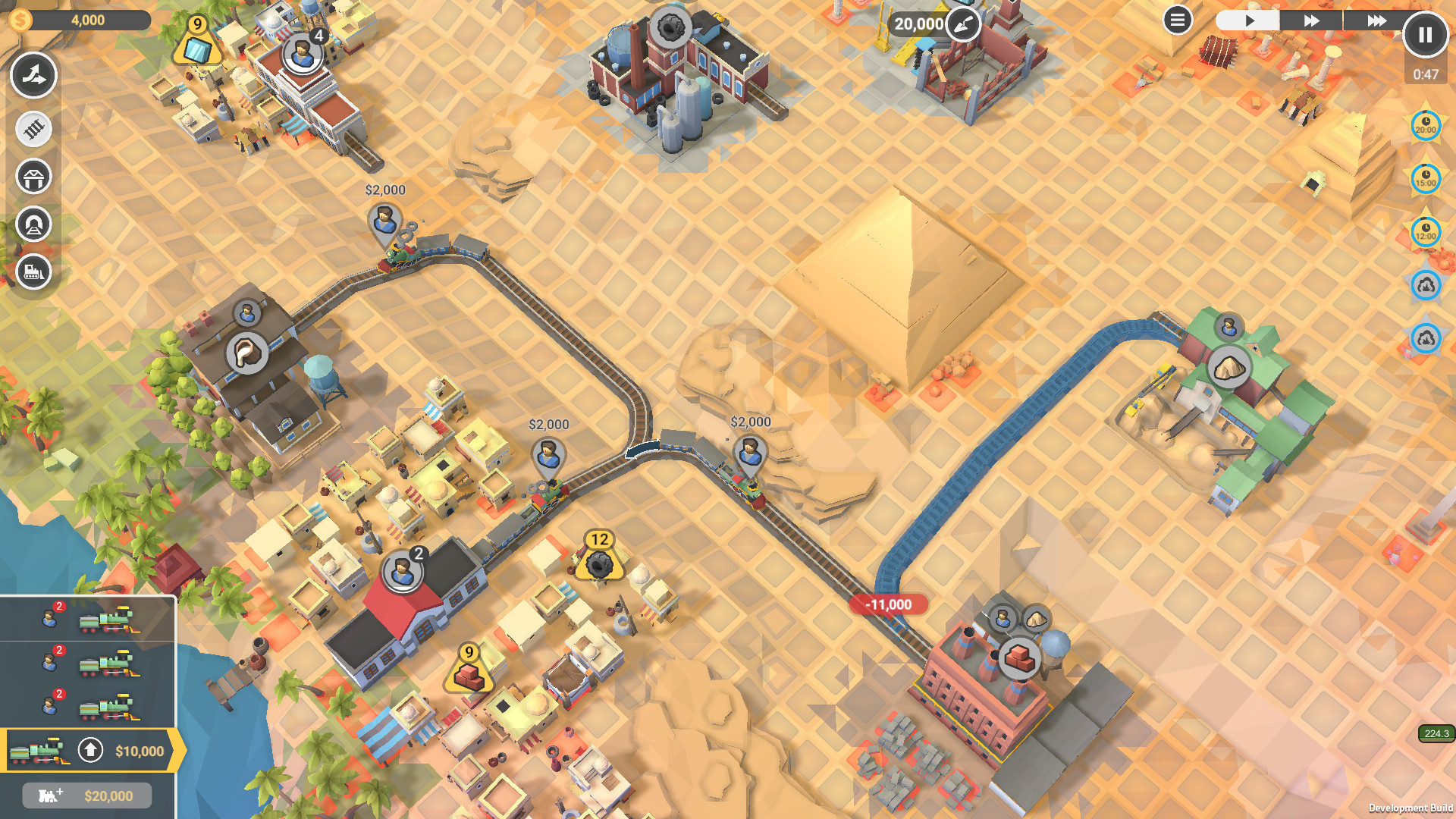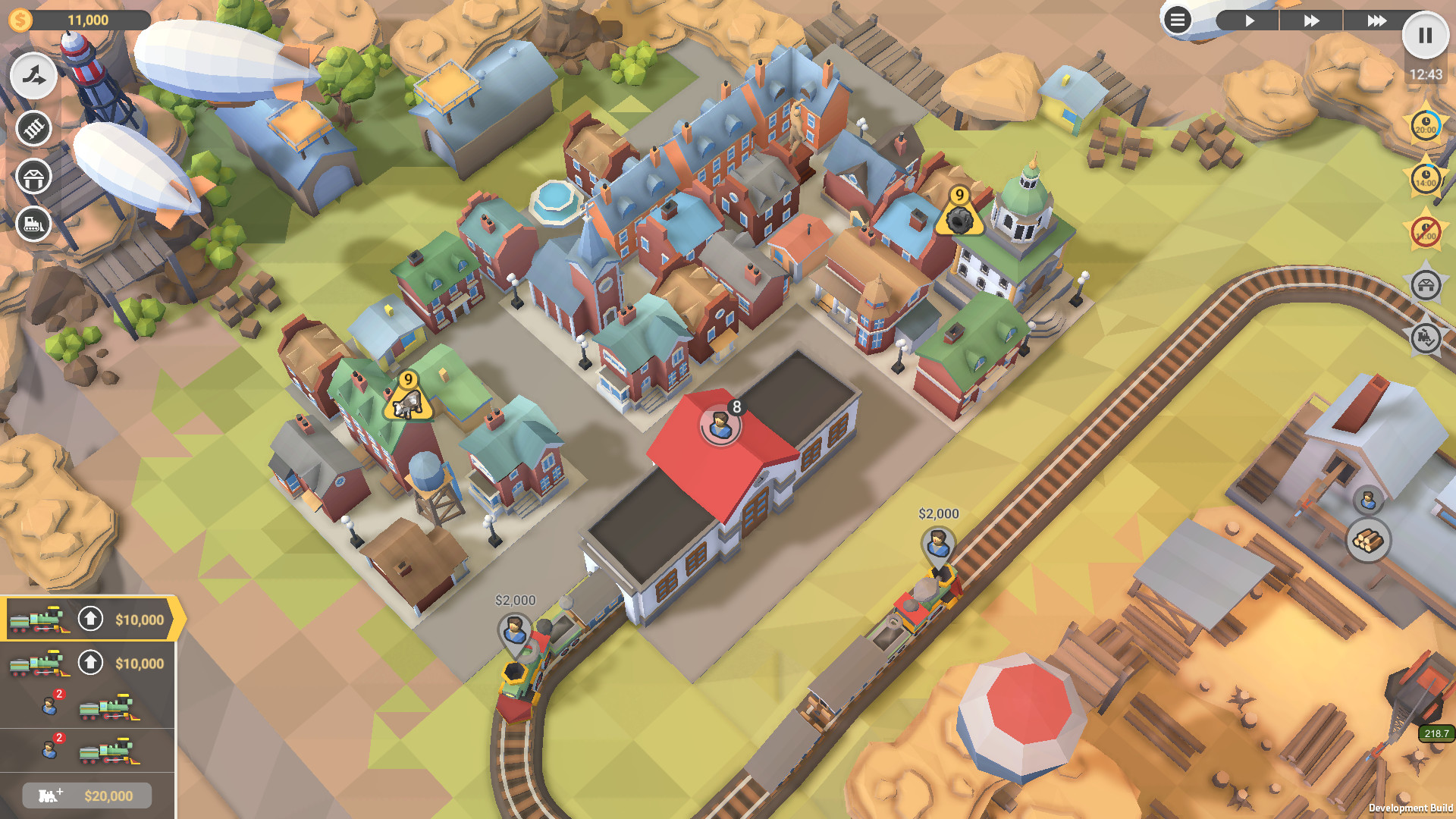Train Valley 2 is a train tycoon puzzle game. Take your railroad company from the days of the Industrial Revolution and into the future, meeting the needs of the valley's cities and industries. Build railroads, upgrade your locomotives, and keep your trains on schedule without delays or accidents. All aboard — the train is leaving the station!

Enjoy engaging and addictive gameplay, combining puzzle micromanagement with tycoon elements.

Discover the history of railroads in elegant low-poly graphics!

Keep your trains running on schedule across 50 levels in Company Mode (*the Early Access version currently offers 20).

Upgrade your stock of locomotives and acquire advanced engines, with 18 models to unlock (*the Early Access version currently features 4).

Produce and ship increasingly sophisticated goods in more than 35 types of train cars (*the Early Access version currently offers 21).

Jump into our Level Editor with Steam Workshop integration and create your own Valleys - or play levels from other players!

Create your own mods with custom locomotives, train cars, industries, and resources from your favorite time or universe.

Enjoy engaging and addictive gameplay, combining puzzle micromanagement with tycoon elements.

Discover the history of railroads in elegant low-poly graphics!

Keep your trains running on schedule across 50 levels in Company Mode (*the Early Access version currently offers 20).

Upgrade your stock of locomotives and acquire advanced engines, with 18 models to unlock (*the Early Access version currently features 4).

Produce and ship increasingly sophisticated goods in more than 35 types of train cars (*the Early Access version currently offers 21).

Jump into our Level Editor with Steam Workshop integration and create your own Valleys - or play levels from other players!

Create your own mods with custom locomotives, train cars, industries, and resources from your favorite time or universe.
Locomotive 5-2 (The Caiman)
The E.444 was a success, but in just a few years the FSI realized they needed new locomotives not just faster and more potent, but also more modern, adapted to modern systems of control (instead of just to the old electromechanical systems). After 40 years of service, the first Italian-made locomotives were obsolete not to say simply limping its way after many tweaks repairs. On top of that, more modern engines such as the E.646 were less and less useful due to the increasing number of passengers after the economic recovery of the 50s and 60s, the Italian miracle. In order to avoid problems transitioning to a brand new type of machines, they decided not to start a design from scratch, go back to the field-tested E.636 and modernize it. The first E.656 was built in 1975; when they went out of production in 1989, a total of 461 engines had been built over the years. The E.656 has a B-B-B wheel configuration: three independent two-axle bogies, all of them individually powered by separate traction motors. Its a rheostatic electric engine which means that it uses a system of resistance to avoid excessive amperage at its start, thus reducing the risk of an electric overload. Funny enough, even though it is more powerful than the Tartaruga, with a +25% tractive effort, it is also significantly slower (150 km/h vs 200 km/h) at least in ideal circumstances: in old lines, or when coupled to old coaches, the Tartaruga could not reach its max speed anyway.
 (Photo from Wikipedia )
(Photo from Wikipedia )
The E.656 are all-purpose locomotives and they have been used on every kind of work, from freight to passenger transport. Reliable and powerful, they are capable of hauling heavy loads in difficult terrains of which the mountainous Italy has quite a lot. Its nickname, the Caimano (alligator) was chosen by an actual train lover, just like you: every time the FSI built a new locomotive, they called a contest in its official magazine to choose a name with the fans. Of all the entries, they liked Caimano the most and just like it happened with the Tartaruga, they painted the animal of the new logo on the sides of the locomotives. Although with significant updates and tweaks, the Caimanos are still in service in the Italian railways.
In the in-game counterpart of the Caimano you can see featured the same rectangular-shaped windows, the circular ones in the sides, the prominent front, and its two circular lights. The E.656 collects its power from an overhead line, so in this locomotive you can also see the pantograph in the frontal part of the roof.
Thats it for this weeks glimpse at the history of locomotives, but we suggest you not to bring your luggage down, for in next weeks blog were going really far, far away, to discover the history of the railway in China and one of its locomotives. Until then, get ready for the ride, train lovers! tv2conductor
 Good day, train lovers! Were back at our series of vignettes about the history of locomotives. Last week, we entered the Electrical Era and discovered the ChS8, a powerful machine with an unkind fate: built to be the cornerstone of long-distance passenger trains, it almost fell to oblivion after the collapse of the USSR. Today we start our historical trip going from the cold steppes of Russia and Ukraine to the warm and sunny shores of the Mediterranean sea: lets travel to Italy!
Good day, train lovers! Were back at our series of vignettes about the history of locomotives. Last week, we entered the Electrical Era and discovered the ChS8, a powerful machine with an unkind fate: built to be the cornerstone of long-distance passenger trains, it almost fell to oblivion after the collapse of the USSR. Today we start our historical trip going from the cold steppes of Russia and Ukraine to the warm and sunny shores of the Mediterranean sea: lets travel to Italy!
FS Class E-656: the Caimano
After the Second World War, the Italian national railroad company FSI (Ferrovie dello Stato Italiane) decided to invest in new locomotives, faster and more potent. The E.626 and E.636, built during the Fascist regime, were simply not powerful enough. In 1953, the FSI started working in a new model engine meant to be mounted on the modified chassis of the E.636. Five years later, the first prototypes of the E.646 and E.645 locomotives were produced. Just a few years later they designed and built a 4-axle locomotive with a similar concept, the high-speed E.444, which would be ironically nicknamed the Tortoruga (tortoise).The E.444 was a success, but in just a few years the FSI realized they needed new locomotives not just faster and more potent, but also more modern, adapted to modern systems of control (instead of just to the old electromechanical systems). After 40 years of service, the first Italian-made locomotives were obsolete not to say simply limping its way after many tweaks repairs. On top of that, more modern engines such as the E.646 were less and less useful due to the increasing number of passengers after the economic recovery of the 50s and 60s, the Italian miracle. In order to avoid problems transitioning to a brand new type of machines, they decided not to start a design from scratch, go back to the field-tested E.636 and modernize it. The first E.656 was built in 1975; when they went out of production in 1989, a total of 461 engines had been built over the years. The E.656 has a B-B-B wheel configuration: three independent two-axle bogies, all of them individually powered by separate traction motors. Its a rheostatic electric engine which means that it uses a system of resistance to avoid excessive amperage at its start, thus reducing the risk of an electric overload. Funny enough, even though it is more powerful than the Tartaruga, with a +25% tractive effort, it is also significantly slower (150 km/h vs 200 km/h) at least in ideal circumstances: in old lines, or when coupled to old coaches, the Tartaruga could not reach its max speed anyway.
 (Photo from Wikipedia )
(Photo from Wikipedia )The E.656 are all-purpose locomotives and they have been used on every kind of work, from freight to passenger transport. Reliable and powerful, they are capable of hauling heavy loads in difficult terrains of which the mountainous Italy has quite a lot. Its nickname, the Caimano (alligator) was chosen by an actual train lover, just like you: every time the FSI built a new locomotive, they called a contest in its official magazine to choose a name with the fans. Of all the entries, they liked Caimano the most and just like it happened with the Tartaruga, they painted the animal of the new logo on the sides of the locomotives. Although with significant updates and tweaks, the Caimanos are still in service in the Italian railways.
In the in-game counterpart of the Caimano you can see featured the same rectangular-shaped windows, the circular ones in the sides, the prominent front, and its two circular lights. The E.656 collects its power from an overhead line, so in this locomotive you can also see the pantograph in the frontal part of the roof.
Thats it for this weeks glimpse at the history of locomotives, but we suggest you not to bring your luggage down, for in next weeks blog were going really far, far away, to discover the history of the railway in China and one of its locomotives. Until then, get ready for the ride, train lovers! tv2conductor
[ 2019-04-07 20:05:30 CET ] [Original Post]
Minimum Setup
- OS: Ubuntu 12.04+ or SteamOS+
- Processor: 2.2 GHz CPUMemory: 2 GB RAM
- Memory: 2 GB RAM
- Graphics: ATI Radeon HD 2400 or NVIDIA GeForce 7600
- Storage: 1 GB available space
Recommended Setup
- OS: Ubuntu 12.04+ or SteamOS+
- Processor: 2.2 GHz CPUMemory: 4 GB RAM
- Graphics: NVIDIA GeForce GTX1050 Ti or higher
- Storage: 1 GB available space
GAMEBILLET
[ 6425 ]
GAMERSGATE
[ 3784 ]
MacGamestore
[ 2906 ]
FANATICAL BUNDLES
HUMBLE BUNDLES
by buying games/dlcs from affiliate links you are supporting tuxDB

